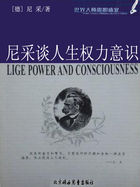Moreover,if the expression bears many senses,while the answererdoes not understand or suppose it to have them,surely thequestioner here has directed his argument against his thought! Orhow else ought he to put his question except by suggesting adistinction—suppose one”s question to be speaking of the silentpossible or not?”—as follows,”Is the answer "No" in one sense,but"Yes" in another?” If,then,any one were to answer that it was notpossible in any sense and the other were to argue that it was,has nothis argument been directed against the thought of the answerer?Yethis argument is supposed to be one of those that depend on theexpression.There is not,then,any definite kind of arguments that isdirected against the thought.Some arguments are,indeed,directedagainst the expression:but these are not all even apparentrefutations,let alone all refutations.For there are also apparentrefutations which do not depend upon language,e.g.those thatdepend upon accident,and others.
If,however,any one claims that one should actually draw thedistinction,and say,”By "speaking of the silent" I mean,in onesense this and in the other sense that”,surely to claim this is inthe first place absurd (for sometimes the questioner does not seethe ambiguity of his question,and he cannot possibly draw adistinction which he does not think to be there):in the second place,what else but this will didactic argument be?For it will makemanifest the state of the case to one who has never considered,anddoes not know or suppose that there is any other meaning but one.
For what is there to prevent the same thing also happening to us incases where there is no double meaning?”Are the units in four equalto the twos?Observe that the twos are contained in four in onesense in this way,in another sense in that”.Also,”Is theknowledge of contraries one or not?Observe that some contraries areknown,while others are unknown”.Thus the man who makes this claimseems to be unaware of the difference between didactic and dialecticalargument,and of the fact that while he who argues didactically shouldnot ask questions but make things clear himself,the other shouldmerely ask questions.
Moreover,to claim a ”Yes” or ”No” answer is the business not of aman who is showing something,but of one who is holding anexamination.For the art of examining is a branch of dialectic and hasin view not the man who has knowledge,but the ignorant pretender.He,then,is a dialectician who regards the common principles with theirapplication to the particular matter in hand,while he who onlyappears to do this is a sophist.Now for contentious and sophisticalreasoning:(1) one such is a merely apparent reasoning,on subjects onwhich dialectical reasoning is the proper method of examination,even though its conclusion be true:for it misleads us in regard tothe cause:also (2) there are those misreasonings which do not conformto the line of inquiry proper to the particular subject,but aregenerally thought to conform to the art in question.For falsediagrams of geometrical figures are not contentious (for the resultingfallacies conform to the subject of the art)—any more than is anyfalse diagram that may be offered in proof of a truth—e.g.
Hippocrates” figure or the squaring of the circle by means of thelunules.But Bryson”s method of squaring the circle,even if thecircle is thereby squared,is still sophistical because it does notconform to the subject in hand.So,then,any merely apparentreasoning about these things is a contentious argument,and anyreasoning that merely appears to conform to the subject in hand,even though it be genuine reasoning,is a contentious argument:for itis merely apparent in its conformity to the subject—matter,so that itis deceptive and plays foul.For just as a foul in a race is adefinite type of fault,and is a kind of foul fighting,so the artof contentious reasoning is foul fighting in disputation:for in theformer case those who are resolved to win at all costs snatch ateverything,and so in the latter case do contentious reasoners.Those,then,who do this in order to win the mere victory are generallyconsidered to be contentious and quarrelsome persons,while thosewho do it to win a reputation with a view to ****** money aresophistical.For the art of sophistry is,as we said,” a kind of artof money—****** from a merely apparent wisdom,and this is why theyaim at a merely apparent demonstration:and quarrelsome persons andsophists both employ the same arguments,but not with the samemotives:and the same argument will be sophistical and contentious,but not in the same respect; rather,it will be contentious in sofar as its aim is an apparent victory,while in so far as its aim isan apparent wisdom,it will be sophistical:for the art of sophistryis a certain appearance of wisdom without the reality.The contentiousargument stands in somewhat the same relation to the dialectical asthe drawer of false diagrams to the geometrician; for it beguiles bymisreasoning from the same principles as dialectic uses,just as thedrawer of a false diagram beguiles the geometrician.But whereas thelatter is not a contentious reasoner,because he bases his falsediagram on the principles and conclusions that fall under the art ofgeometry,the argument which is subordinate to the principles ofdialectic will yet clearly be contentious as regards other subjects.















